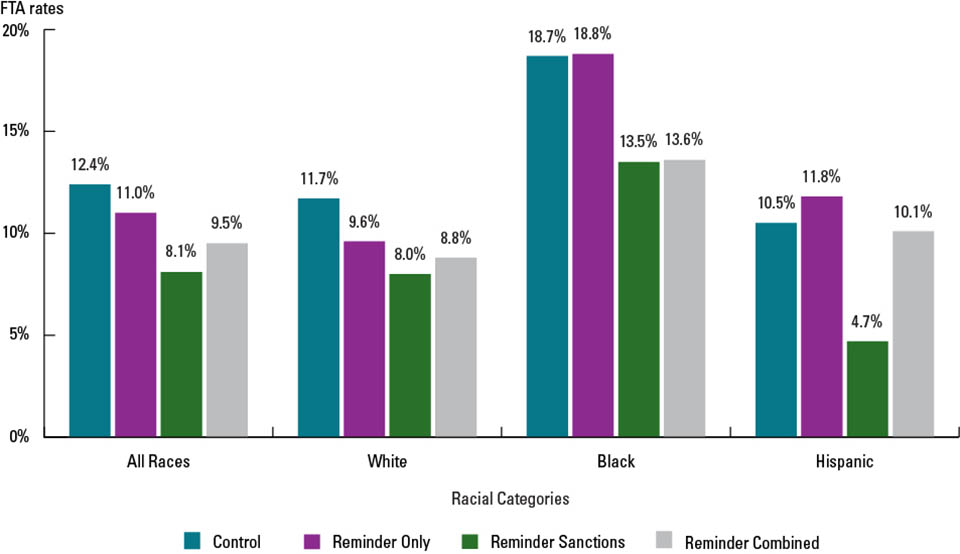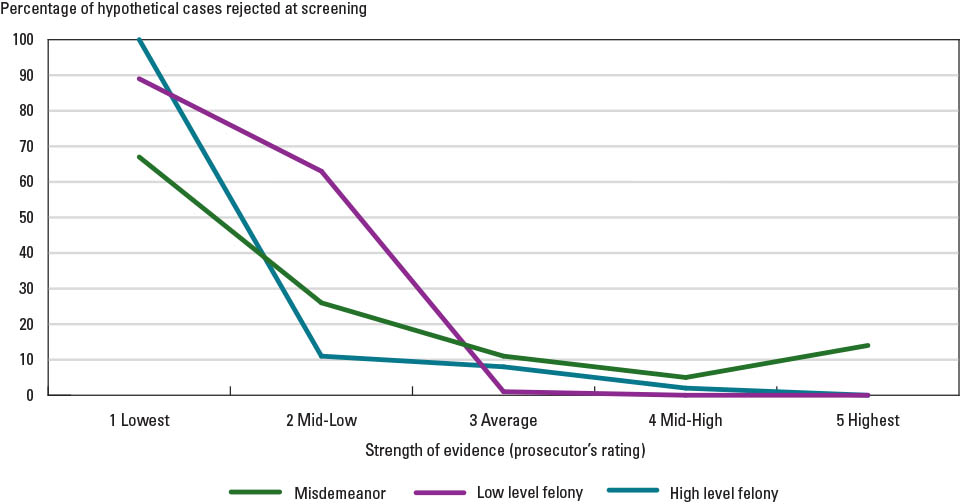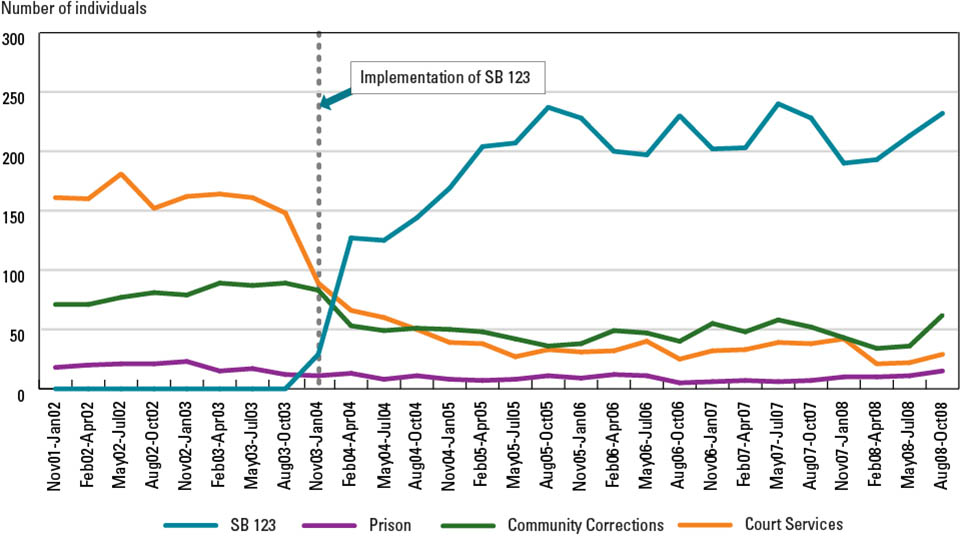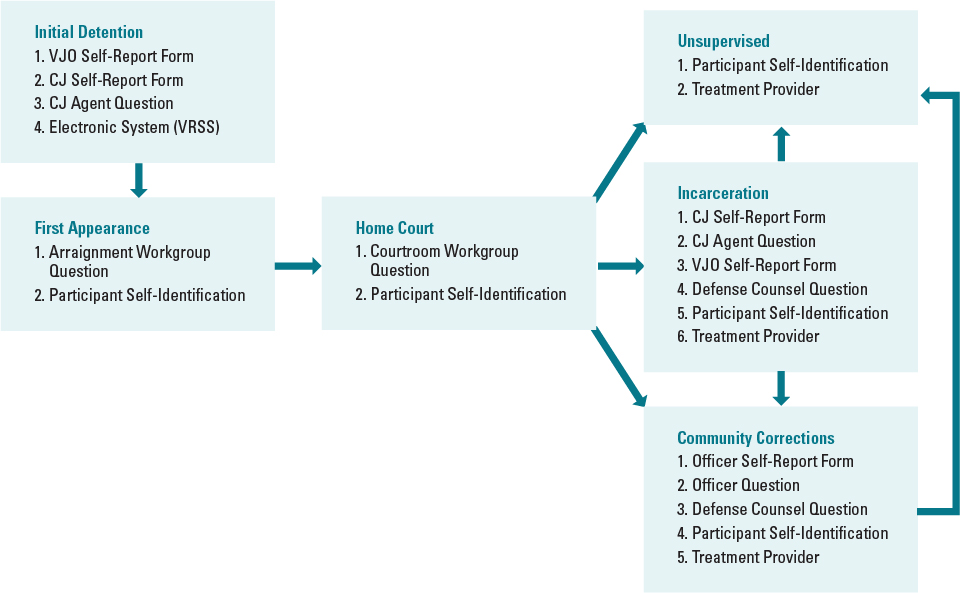NIJ seeks programs that are interested in participating in the NIJ Multisite Impact and Cost -Efficiency Evaluation of Veterans Treatment Courts. To learn more, see the webinar on NIJ’s Multisite Impact and Cost-Efficiency Evaluation of Veterans Treatment Courts.
If your organization is interested in becoming a research partner site, contact us at [email protected].
If your program is interested in becoming a research partner site, contact us at [email protected].
The link between post-traumatic stress disorder (PTSD) and substance use disorder is well documented in military populations, especially among veterans who return from deployment with a traumatic brain injury.[1] Veterans treatment courts (VTCs) have expanded rapidly in the past 10 years to accommodate individuals with a history of military service who enter the criminal justice system on charges ranging from driving while intoxicated to property and violent offenses. Like other types of problem-solving courts, VTCs involve multidisciplinary teams that employ a system of supervision combined with treatment and rehabilitation services to reduce relapse and recidivism. However, VTCs lack research-based guidance on target populations and basic program operations.
See “Preliminary Veterans Treatment Court Study”
This article profiles key studies in the National Institute of Justice’s (NIJ) Courts Research Portfolio on pretrial, prosecution, and sentencing policies that address alternatives to incarceration, including VTCs and other problem-solving courts. Collectively, these research projects demonstrate a history of successful collaborations with federal agencies, court professionals, stakeholders, and expert research teams. This article also highlights findings from NIJ’s Multisite Evaluation of VTCs and discusses recommendations for practice and future research. Together, all of these underscore the need to promote data and research capacity to inform practice and policy, which inspired NIJ’s Courts Strategic Research Plan, 2020-2024.[2] The plan documents NIJ’s commitment to furthering the Department of Justice’s mission through court research, evaluation, and policy analysis.
NIJ’s Courts Research Portfolio
NIJ’s Multisite Evaluation of VTCs and other problem-solving court evaluations fall under the Institute’s Courts Research Portfolio. Its purpose is to sponsor research, development, and evaluation to identify court tools, programs, and policies that satisfy criminal justice goals, including public safety, cost-efficiency, and fair and equitable treatment of victims and individuals charged with a crime. Over the past 50 years, the portfolio has supported important research on court operations and case processing, prosecution and indigent defense services, and criminal adjudication and sentencing. Highlighted here are key studies that address alternatives to incarceration in the context of pretrial, prosecution, and sentencing research, followed by a discussion of VTCs and other problem-solving courts.
Pretrial Research
NIJ has an extensive history of research on the pretrial phase of criminal cases — the first opportunity to divert individuals charged with a crime from incarceration. Pretrial detention can disrupt employment and community ties for sometimes minor offenses, result in jail overcrowding that could then lead to the early release of incarcerated persons who were sentenced, and, more recently, create heightened concerns for the health of incarcerated persons and corrections staff.
In 2007, NIJ convened researchers, practitioners, and other experts who helped identify the following priorities for pretrial research:[3]
- Risk Assessment: What risk factors best determine eligibility for release versus detention?
- Public Safety: What are the rates and predictors of pretrial release violation, including new offenses?
- Court Appearances: What are the rates and predictors of failure to appear in court?
- Community Supervision: Under what conditions can individuals charged with a crime be released pretrial, and what community-based programming improves pretrial release success?
- Costs and Benefits: Under what conditions do the savings associated with pretrial release outweigh the costs of recidivism, failure to appear, and detention?
- What are other important issues, such as disparity in case processing and special cases involving serious mental illness, juveniles, and domestic violence?
NIJ research grants have since examined court notification strategies to address failure to appear for hearings (see exhibit 1). For persons charged with misdemeanors who were randomly assigned to four notice conditions prior to their court date, researchers found that any court appearance reminder was better than none (the control condition), and a more substantive reminder that made them aware of possible sanctions should they fail to appear (reminder sanctions) was better. However, a notification that mentioned sanctions but also highlighted positive consequences in the form of the procedural justice elements of voice, neutrality, respect, and public interest (reminder combined) was no more effective than the sanctions reminder alone.
The failure to appear rate was higher among Black individuals charged with a crime. This seemed to be driven by criminal history correlated with race and ethnicity. A follow-up survey suggested that those who appeared in court had higher institutional confidence and felt they had been treated more fairly by the criminal justice system. Nevertheless, a sanctions reminder was most effective overall.[4]
More recently, a quasi-experimental investigation found that pretrial risk assessments can facilitate nonfinancial release, though with a potentially higher rate of pretrial rearrest, and that structured guidelines may help maximize pretrial release while minimizing misconduct.[5] NIJ is currently funding a process, impact, and cost evaluation of Kentucky’s statewide pretrial court notification system with alternate contacts and messages.[6]
Prosecution Research
A basic line of court research concerns prosecutors ― specifically their decision-making. It examines discretion and the role of evidence and other factors in charging, plea bargains, and other case decisions. Highlights from NIJ’s past qualitative and quantitative research include the following studies.
Strength of Evidence: Researchers examined the strength of evidence in plea bargaining from the perspectives of prosecutors, defense attorneys, and judges. They used hypothetical robbery case scenarios that varied by evidence type — specifically eyewitness, confession, and DNA — and by the characteristics of individuals charged with a crime, such as criminal history. The researchers concluded that “bargaining in the shadow of the trial” applies to prosecutors who assess the probability of conviction and plea discounts. The researchers found that judges focus only on plea discounts and, although defense attorneys focus on both, they focus more on plea discounts. The researchers also found that the number of evidence pieces is important but varies by crime, and that eyewitness identification rated higher than DNA or confession in determining probability of conviction.[7]
Discretion: Researchers examined the influence of extra-legal factors on decision-making and case outcomes in two county prosecutor offices. They collected information through case records, opinion surveys, interviews, focus groups, and factorial surveys that yield responses to hypothetical case vignettes. As shown in exhibit 2, the researchers found that the objective strength of evidence was the determining factor in most screening decisions; that is, prosecutors first asked “Can I prove the case?” Then prosecutors considered contextual factors, including offense severity, criminal history, and victim characteristics. In other words, they asked “Should I prove the case?” The researchers found that all decisions were constrained by office policies, resources, and working relationships with judges and other agencies.[8]
Disparity: Researchers partnered with the New York County District Attorney’s Office to track discretionary decisions along the criminal case process. They examined case files, conducted interviews, and found that the district attorney prosecuted nearly all cases brought by the police with no marked racial or ethnic differences at screening. Black and Latino individuals charged with a crime benefited more from case dismissals but were also more likely to be detained, receive a custodial plea offer, and be incarcerated.[9]
Leveraging the Bureau of Justice Statistics’ Federal Justice Statistics Program, another researcher found that U.S. Attorney case declinations were due to weak or insufficient evidence more than age, race, or gender disparities, and that Black and Hispanic individuals charged with a crime were more likely to receive charge reductions. However, young men belonging to racial and ethnic minority groups were less likely to have their cases declined or charges reduced, and outcomes varied across federal districts.[10]
As part of a current NIJ grant, researchers are conducting a statewide study of felony cases to examine discretion and outcomes, such as any racial or ethnic disadvantage in case processing.[11]
Sentencing Research
Criminal or penal law is the statutory or common law that defines criminal offenses and punishment. Research interests in this area include mandatory minimums, sentencing guidelines, and other legislation that modifies penal code severity and associated sentences with implications for corrections. NIJ has funded several studies on sentencing guidelines and related policies, including two studies that examine sentencing legislation reform designed to promote alternatives to incarceration for individuals convicted of nonviolent drug offenses.
Mandated Treatment: Signed into law in 2003, Kansas Senate Bill 123 mandated community-based supervision and substance abuse treatment for nonviolent individuals convicted of a first or second offense of drug possession. Researchers found that the law improved the lines of communication between agencies and promoted a team approach between supervising officers, drug treatment providers, and people on probation. However, they also found that it kept few from prison at sentencing, had no impact on recidivism rates relative to other community-based sanctions, and had a minimal impact on prison populations (see exhibit 3). The researchers concluded that this minimal impact resulted from structural aspects of the law, including narrow eligibility requirements and mandatory sentencing and supervision procedures.[12]
Treatment Diversion: Legislation to reform New York state drug laws in 2009 removed minimum sentences that had been previously mandated under the state’s Rockefeller drug laws. The new statutes allowed shorter prison and jail sentences and expanded alternatives to incarceration, including court-mandated treatment programs. Researchers examined the impact of this legislation on felony drug cases indicted in New York City. They found a modest increase in judicial diversion and a decrease in criminal sentences to incarceration. Controlling for other factors connected with recidivism, the researchers found diversion to treatment was associated with lower rates of rearrest on both misdemeanor and felony charges. However, implementation varied widely across counties. Citywide, the overwhelming majority of drug arrests did not result in diversion to treatment, preventing an assessment of the full impact of the legislation. Savings to law enforcement, corrections, and victims resulting from decreased recidivism were outweighed by higher treatment costs related to the increased use of residential over outpatient services.[13]
NIJ’s Multisite Evaluation of Veterans Treatment Courts
What Are Veterans Treatment Courts?
Modeled after mental health and drug courts, VTCs are dedicated court dockets that support persons with military service who are in the criminal justice system and have been diagnosed with substance use disorders or mental health issues and other rehabilitation needs. Stable housing is chief among those needs, and groups like the U.S. Interagency Council on Homelessness (USICH) seek to prevent and end homelessness among veterans. USICH recognizes that VTCs and other veteran-focused courts support its strategic priority to promote alternatives to criminalizing people experiencing homelessness[14] by emphasizing treatment for mental health and substance use disorders rather than punishment and incarceration.[15]
The original VTC model developed in 2008[16] underlies the program guidance used today:[17]
- Integration of alcohol and drug treatment and mental health services with case processing.
- Nonadversarial court approach with due process protections.
- Early identification and program placement.
- Continuum of treatment and rehabilitative services (including peer mentors).
- Frequent alcohol and drug testing and other monitoring.
- Graduated sanctions and incentives.
- Ongoing judicial interaction and court supervision.
- Continuing interdisciplinary team education.
- Partnerships with the U.S. Department of Veterans Affairs (VA), public agencies, and community-based organizations.
The VA’s Veterans Justice Outreach (VJO) Program[18] currently serves over 600 VTCs and other veteran-focused courts. VJO specialists are members of the VTC program team who act as liaisons between the courts and the VA, conduct needs assessments, and facilitate service access.[19]
The Bureau of Justice Assistance (BJA) administers the Department of Justice’s Veterans Treatment Court Program and provides grants and technical assistance to state, local, and tribal governments to develop and maintain VTCs.[20] BJA encourages drug courts to adopt evidence-based practice standards, although program models vary. In contrast to its grants for adult drug courts, BJA funds grants to VTC programs for individuals charged with either violent or nonviolent offenses.[21]
In addition, the Substance Abuse and Mental Health Services Administration (SAMHSA) supports VTCs by funding grants to expand the treatment capacity of community-based treatment services instead of incarcerating individuals with substance use disorders.[22] SAMHSA also provides technical assistance for improving behavioral health services and supports for military service members, veterans, and their families.[23]
Research Findings
In collaboration with the VA, BJA, and SAMHSA, NIJ funded a multisite evaluation of VTCs to answer basic questions, including the following:
- What are the characteristics and needs of VTC participants, and what services did they access?
- What are the structures, policies, and practices of VTC programs?
- What are the short-term program and participant outcomes?
The principal investigators assembled a team of researchers across eight VTC programs, which were chosen for their variety with respect to size, maturity, rurality, and other characteristics.
See “Research Partner Site Perspective on NIJ’s Multisite Evaluation of Veterans Treatment Courts”
They conducted structured observations, surveyed VTC teams and service providers, reviewed program documents and agency records, and interviewed 318 participants (with follow-ups at 12 and 24 months). The following are highlights of findings from the study:[24]
- Driving while intoxicated cases may be the most frequent type of referral to the VTC programs. Most participants reported using alcohol and marijuana, and many reported high levels of exposure to stimulants while in service and via treatment regimens.[25] Programs mandated drug testing and treatment for mental health and substance use disorder issues, and compliance with medication prescriptions.
- Participants varied in age and other characteristics across the programs, but the overall majority were male and white (25% Black, 13% Hispanic) and had served in the Army (including the Reserves and National Guard) and in recent conflicts.[26] Most had deployed to combat zones, received hazard pay, and experienced physical or psychological injury related to service.
- Mental health issues reported most frequently by VTC participants included aggression, depression, insomnia, and PTSD (see exhibit 4). Traumatic brain injury, phobias, and other issues became more prevalent during and after service.
- Program manuals did not document the protocols used to identify eligible participants. Multiple agents made referrals at all stages of case processing, and referrals were more often based on self-reported veteran status than on military records (see exhibit 5).
- The criteria considered for program eligibility were: military status, such as excluding those with dishonorable discharges;[27] current charges and criminal history, such as excluding those charged with sex and other violent felony offenses; and mental health and substance use, especially if related to military service.
- All programs used a sanctions and incentives system, but some VTC staff were critical of how well the system was communicated to clients, how consistently sanctions and incentives were applied, and whether the incentives for complying were adequate.
- The programs were successful in implementing the VTC model with fidelity, specifically in creating collaborative relationships, integrating substance use disorder and mental health treatment, and providing a continuum of rehabilitation services. They were less able to promptly identify and refer participants, respond effectively to noncompliance, or offer the team continuing education.
- All but one program reported graduation rates of 50% or better; variation across programs may relate to the target population (that is, there was a lower rate if the program served individuals at high risk of offending). Participants reported very low rearrest rates, although the interview sample was biased toward active program participants, missing those participants who were terminated.
| Issue | Ever Experienced |
|---|---|
| Depression | 275 (87.9%) |
| Aggression | 275 (87.9%) |
| Post-Traumatic Stress Disorder | 263 (84.0%) |
| Insomnia | 263 (84.0%) |
| Anxiety | 230 (73.5%) |
| Suicide Ideation | 169 (54.0%) |
| Panic Disorder | 168 (53.7%) |
| Paranoia | 158 (50.5%) |
| Concussion | 147 (47.0%) |
| Obsessive Compulsive Disorder | 121 (38.7%) |
| Traumatic Brain Injury | 112 (35.8%) |
| Phobias | 82 (26.2%) |
| Bipolar | 80 (25.6%) |
Note: n=313
Julie Marie Baldwin and Richard D. Hartley, "Executive Summary: National Institute of Justice’s Multisite Evaluation of Veterans Treatment Courts," Final report to the National Institute of Justice, award number 2015-VV-BX-K020, July 2022, NCJ 305014.
This study relied on the programs to provide information on VTC participants, and on a convenience sample of active participants to self-report recidivism and other outcomes. Based on their experiences, the researchers identified several recommendations for future studies and ongoing self-assessment by the programs. Recommendations include partnering with researchers for formative program assessments, as well as more proactive self-monitoring by the programs, including tracking referrals and participants through termination and post-program. This information is necessary to confirm that the program is equally accessible to everyone in the targeted population, that its resources align with the services that participants need, and to identify patterns of behavior that affect program retention. Information on criminal history and other aspects of participants’ backgrounds, as well as housing and other dynamic factors, will aid in interpreting graduation, relapse, and recidivism outcomes across participants and over time. Research methods should include: interviews and objective records collection for all participants admitted to the program (regardless of their program status, incarceration, etc.); and independent verification of arrests and other program violations, as well as criminal justice contacts and treatment service access, which are community supervision conditions.
Forthcoming Research Dissemination and Funding Opportunities
NIJ issued the Courts Strategic Research Plan, 2020-2024[28] to communicate its continued commitment to advancing research on courts.
See “NIJ’s Courts Strategic Research Plan”
The plan identifies a comprehensive set of objectives and action items under four strategic research priorities:
- Develop the courts workforce and enhance court workgroups.
- Advance court practice.
- Support the fair and impartial administration of justice.
- Promote data and research capacity building.
Collaboration with federal agencies, court professionals, stakeholders, and court expert research teams has been key to the success of NIJ’s Courts Research Portfolio. NIJ will disseminate research findings via the National Drug Court Resource Center[29] and other practitioner outlets, and develop future research projects that examine the impact and cost-efficiency of VTCs in fiscal year 2022.[30] NIJ plans to fund pretrial, prosecution, and other court research under its Research and Evaluation on the Administration of Justice notice of funding opportunity.[31] And NIJ will continue to promote jurisdictions’ capacity for data and rigorous applied research that will inform the field’s efforts to protect public safety, deliver justice fairly, and examine alternatives to incarceration and other policy innovations.
For More Information
About This Article
This article was published as part of NIJ Journal issue number 284.
Sidebar: Preliminary Veterans Treatment Court Study
Before embarking on more rigorous impact and cost-efficiency evaluations, NIJ collaborated with federal partners on a preliminary process and implementation study to examine a variety of veterans treatment court programs. Researchers found a mix of pre- and post-plea tracks, program participants including active service members, and more mental health and other service needs than criminal histories. They also discovered challenges in conducting participant interviews and obtaining the records necessary to analyze graduation and other program outcomes, as well as recidivism and other participant outcomes.
Sidebar: New Funding Opportunity
In partnership with up to six veterans treatment courts across the United States, NIJ sought fiscal year (FY) 2022 research applications for a $3 million cooperative agreement to conduct a cross-site impact and cost-efficiency evaluation. Read “NIJ Multisite Impact and Cost-Efficiency Evaluation of Veterans Treatment Courts, FY 2022.”
Sidebar: Research Partner Site Perspective on NIJ’s Multisite Evaluation of Veterans Treatment Courts
Among the oldest programs in NIJ’s study, Travis County (Texas) Veterans Court originated with support from the Governor’s Office Criminal Justice Division and the Texas Indigent Defense Commission to promote evidence-based practices and effective funding strategies.[32] The court now accepts veterans with PTSD related to sexual trauma during military service, as well as violent offenses involving assault and weapons. As veterans treatment court coordinator Jolene Grajczyk noted, they realized “there’s a bigger population to be served among returning veterans.” They felt program changes happened organically, and the research validated their approach of addressing individual needs with counseling, monitoring, and other services. A former Army enlisted man, Judge Brad Urrutia explained that they do not take a highly structured military approach because “We don’t know what triggers veterans.” Instead, he advises, “Let’s take our common background and decide how we’re going to apply it to civilian life.”
Sidebar: NIJ’s Courts Strategic Research Plan
NIJ’s Courts Strategic Research Plan, 2020-2024[33] identifies a comprehensive set of objectives and action items under four strategic research priorities. The first priority is promoting and supporting research to develop the courts’ workforce at all phases of professional development: education, recruitment, training, mentoring, coaching, leadership, and retention. The focus is not only on individuals, but also on interpersonal supports and organizational values that affect work group norms.
The second priority addresses the basic concerns of courts and related agencies, such as court operations, case management, case outcomes, and court policies and procedures. These require constant assessment and change to maintain the court’s capacity to respond to contemporary case needs. Topics of interest include information sharing, videoconferencing and other technologies, specialized case units or court dockets, forensic evidence, pretrial services, sentencing, victims, witnesses, and juror management.
The third priority focuses on the fair and impartial administration of justice and supports courts in learning more about their multiple and evolving roles. These roles include monitoring cases for conviction integrity, providing appropriate counsel, ensuring that victims’ voices are heard, and preserving the perceived legitimacy of the judicial system. Specific research concerns include the dynamics of the community and criminal justice stakeholders and their influence on the court, as well as the impact of court strategies on the administration of justice and public safety.
The fourth priority is a departure from previous NIJ strategic research plans. It underscores the lack of valid and reliable information necessary to support robust court research studies or self-monitoring and planning efforts by the courts. It addresses the need for strategies that enhance the capacity of courts and related agencies to collect, analyze, and share data. This would improve the quality of research and increase the use of empirical evidence in determining court practice. Enhanced data and information sharing support problem identification, performance measurement, and rigorous research and evaluation efforts.
Resources
National Drug Court Resource Center
Interactive Map of Treatment Courts
Veterans Experiencing Homelessness, Veterans Justice Outreach Programs
Treatment of Co-Occurring PTSD and Substance Use Disorder in VA
BJA Adult Drug Court Discretionary Grant Program
Veterans Treatment Court Grant Program
Service Members, Veterans, and their Families Technical Assistance Center
Federal Justice Statistics Program






